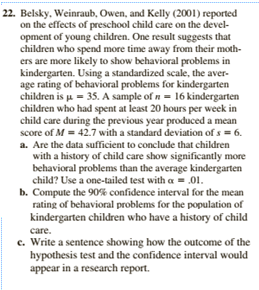22. Belsky, Weinraub, Owen, and Kelly (2001) reported on the effects of preschool child care on the devel- opment of young children. One result suggests that children who spend more time away from their moth- ers are more likely to show behavioral problems in kindergarten. Using a standardized scale, the aver- age rating of behavioral problems for kindergarten children is a = 35. A sample of n - 16 kindergarten children who had spent at least 20 hours per week in child care during the previous year produced a mean score of M= 42.7 with a standard deviation of s= 6. a. Are the data sufficient to conclude that children with a history of child care show significantly more behavioral problems than the average kindergarten child? Use a one-tailed test with a = .01. b. Compute the 90% confidence interval for the mean rating of behavioral problems for the population of kindergarten children who have a history of child care. c. Write a sentence showing how the outcome of the hypothesis test and the confidence interval would appear in a research report.
Family of Curves
A family of curves is a group of curves that are each described by a parametrization in which one or more variables are parameters. In general, the parameters have more complexity on the assembly of the curve than an ordinary linear transformation. These families appear commonly in the solution of differential equations. When a constant of integration is added, it is normally modified algebraically until it no longer replicates a plain linear transformation. The order of a differential equation depends on how many uncertain variables appear in the corresponding curve. The order of the differential equation acquired is two if two unknown variables exist in an equation belonging to this family.
XZ Plane
In order to understand XZ plane, it's helpful to understand two-dimensional and three-dimensional spaces. To plot a point on a plane, two numbers are needed, and these two numbers in the plane can be represented as an ordered pair (a,b) where a and b are real numbers and a is the horizontal coordinate and b is the vertical coordinate. This type of plane is called two-dimensional and it contains two perpendicular axes, the horizontal axis, and the vertical axis.
Euclidean Geometry
Geometry is the branch of mathematics that deals with flat surfaces like lines, angles, points, two-dimensional figures, etc. In Euclidean geometry, one studies the geometrical shapes that rely on different theorems and axioms. This (pure mathematics) geometry was introduced by the Greek mathematician Euclid, and that is why it is called Euclidean geometry. Euclid explained this in his book named 'elements'. Euclid's method in Euclidean geometry involves handling a small group of innately captivate axioms and incorporating many of these other propositions. The elements written by Euclid are the fundamentals for the study of geometry from a modern mathematical perspective. Elements comprise Euclidean theories, postulates, axioms, construction, and mathematical proofs of propositions.
Lines and Angles
In a two-dimensional plane, a line is simply a figure that joins two points. Usually, lines are used for presenting objects that are straight in shape and have minimal depth or width.
Include 5 steps to answer c

Trending now
This is a popular solution!
Step by step
Solved in 2 steps


